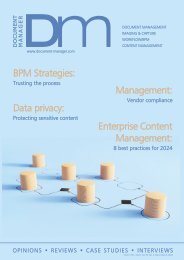Jan-Feb-Mar 2021
You also want an ePaper? Increase the reach of your titles
YUMPU automatically turns print PDFs into web optimized ePapers that Google loves.
OPINION<br />
HOW TO PREPARE IP NETWORK INFRASTRUCTURE FOR THE 5G ERA<br />
VINCENTAS GRINIUS, CEO AT IPXO AND ZILVINAS VAICKUS, HEAD OF INFRASTRUCTURE AT<br />
IPXO, SHARE A FEW POINTERS TO KEEP IN MIND WHILE PLANNING A 5G MIGRATION STRATEGY<br />
The fifth-gen network brings with it<br />
immensely fast data speeds, however,<br />
it has a short-distance reach: the<br />
mmWaves 5G runs on span across only a<br />
few hundred metres. To cast a widespread<br />
net, a denser network of small cell towers<br />
that emit the necessary wavelength have to<br />
be set in place.<br />
For this reason, edge computing is also<br />
stepping into the limelight, in order to<br />
accommodate the need for faster data processing.<br />
With properly set up edge computing<br />
architecture, event processing happens<br />
in the edge node closest to the device.<br />
Consequently, resource-heavy devices can<br />
retrieve data at high speeds as it does not<br />
have to travel long distances to a cloud or<br />
a data centre.<br />
"Fifth-gen requires a tightly-knit network<br />
infrastructure. As speed and scale are<br />
imperative to the new wireless, the proximity<br />
of network components correlates with their<br />
capacity to process information at incredibly<br />
high levels," said Zilvinas Vaickus, Head of<br />
Infrastructure at IPXO.<br />
"Data centres as we know them will<br />
become an old story," Vaickus continued.<br />
"They will clear the way for densely-situated<br />
nodes, which will need to be implemented<br />
to provide the necessary agility in accordance<br />
with the next-gen network."<br />
ASSURING BACKLINK COMPATIBILITY<br />
IPv6 will have a major role to play in 5G,<br />
as IPv4 addresses, which are already in<br />
short supply, could never satisfy the evergrowing<br />
connection demand further down<br />
the road. That said, the majority of systems<br />
in place are IPv4-compatible only. To leverage<br />
in-house equipment alongside new<br />
standards for speed and data processing,<br />
implementing a dual-stack network with the<br />
capacity to process IPv4 and IPv6 traffic<br />
simultaneously becomes a crucial step<br />
when upgrading network architecture.<br />
"To think that with the coming of 5G and<br />
Internet Protocol 6 IPv4s would suddenly<br />
become irrelevant would be unrealistic,"<br />
explained Vincentas Grinius, CEO at IPXO.<br />
"Building an entirely new network of IPv6-<br />
only equipment would be too much of a<br />
grandiose aim that, for most, is not worth<br />
neither the time nor the investment. The<br />
simple truth is that there will always be systems<br />
compatible only with the previous<br />
protocol. Thus dual-stacking is a nonnegotiable<br />
integration when preparing for<br />
5G migration."<br />
Since IPv4 addresses will remain an integral<br />
part of the network, IP leasing platforms<br />
like IPXO will only grow in importance,<br />
as they will be able to lease out<br />
IPv4s necessary to ensure overall backlink<br />
compatibility among systems.<br />
WFH INFRASTRUCTURE CHALLENGE<br />
Although 5G technology is more robust and<br />
advanced compared to its predecessors,<br />
managing its security will not be an easy<br />
task to tackle. Addressing network vulnerabilities<br />
becomes an even more sensitive<br />
issue when you consider the increasing trend<br />
of remote working. As security executives try<br />
to wrap their heads around overseeing all<br />
the possible weak spots concerning the<br />
internal network, now they are obligated to<br />
look even further and define safeguards for<br />
remote workforce.<br />
"Fifth-gen supports a huge amount of connected<br />
devices. Consequently, this means<br />
there is a significantly larger number of possible<br />
access points to attempt to highjack,"<br />
commented Grinius. "While managing core<br />
network security remains the top priority, setting<br />
up a well-structured WFH infrastructure is<br />
definitely coming in as a close second in<br />
terms of preventing possible data breaches.<br />
Personal computers and networks often have<br />
fewer safeguards in place, and thus become<br />
an easy target for scammers."<br />
All in all, with the new generation rapidly<br />
approaching, the focus for most should<br />
remain not necessarily on the benefits 5G will<br />
bring to the table, but rather how to be better<br />
prepared to facilitate smooth integration with<br />
existing networks, ensure device compatibility<br />
and mitigate associated threats. NC<br />
18 NETWORKcomputing JANUARY/FEBRUARY <strong>2021</strong> @NCMagAndAwards<br />
WWW.NETWORKCOMPUTING.CO.UK

















